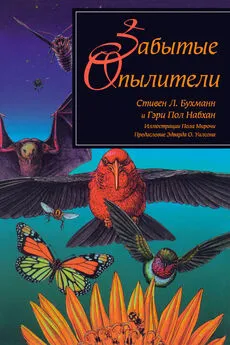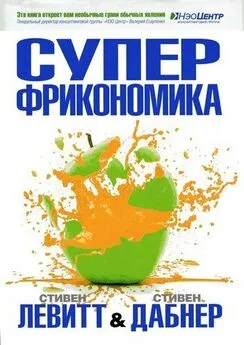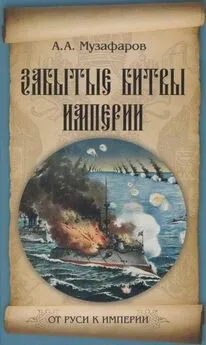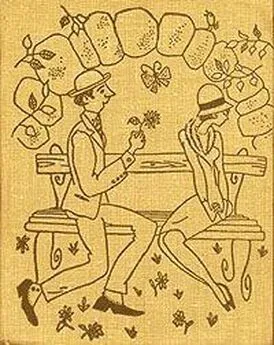Стивен Бухманн - Забытые опылители
- Название:Забытые опылители
- Автор:
- Жанр:
- Издательство:Island Press
- Год:1997
- Город:Washington D. C.
- ISBN:9781597269087
- Рейтинг:
- Избранное:Добавить в избранное
-
Отзывы:
-
Ваша оценка:
Стивен Бухманн - Забытые опылители краткое содержание
Один из авторов книги, Стивен Бухманн, является одним из ведущих мировых специалистов в области опыления и знатоком медоносных пчёл. Второй автор, Гэри Пол Набхан — специалист по этноботанике, эколог, автор множества книг о культуре земледелия и сельскохозяйственных продуктах.
Забытые опылители - читать онлайн бесплатно полную версию (весь текст целиком)
Интервал:
Закладка:
Neff, J. L., and B. B. Simpson. 1993. “Bees, pollination systems and plant diversity.” In J. LaSalle and I. D. Gauld, eds., Hymenoptera and Biodiversity. Wallingford, England: CAB International.
New, T. R., R. M. Pyle, J. A. Thomas, and P. Hammond. 1995. “Butterfly conservation management.” Annual Review of Entomology 40:57–83.
Niklas, K. J. 1992. Plant Biomechanics: An Engineering Approach to Plant Form and Function. Chicago: University of Chicago Press.
Niklas, K. J., and S. L. Buchmann. 1985. “Aerodynamics of wind pollination in Simmondsia chinensis.” American Journal of Botany 72(4):530–539.
——. 1987. “The aerodynamics of pollen capture in two sympatric Ephedra species.” Evolution 41(1):104–123.
Nilsson, L. A. 1992. “Long pollinia on eyes: hawk-moth pollination of Cynorkis uniflora Lindley (Orchidaceae) in Madagascar.” Botanical Journal of the Linnean Society 109:145–160.
Noss, R. F., and A. Y. Cooperrider. 1994. Saving Nature’s Legacy. Washington, D.C.: Island Press.
Olesen, J. M., and S. K. Jain. 1994. “Fragmented populations and their lost interactions.” In V. Lennische, J. Tannah, and S. K. Jain, eds., Conservation Genetics. Bwerkes-Verlag, Switzerland.
O’Neal, R. J., and G. D. Waller. 1982. “On the pollen harvest by the honey bee (Apis mellifera L.) near Tucson, Arizona (1976–1981).” Desert Plants 6:81—109.
Ordway, E., S. L. Buchmann, R. O. Kuehl, and C. W. Shipman. 1987. “Pollen dispersal in Curcubita foetidissima (Cucurbitaceae) by bees of the genera Apis, Peponapis and Xenoglossa (Hymenoptera: Apidae, Anthophoridae).” Journal of the Kansas Entomological Society 60(4):489–503.
Ornelas, J. F. 1994. “Serrate tomia: an adaptation for nectar-robbing in hummingbirds?” The Auk 11(3):703–710.
O’Rourke, M. K., and S. L. Buchmann. 1991. “Standardized analytical techniques for bee-collected pollen.” Environmental Entomology 20(2):507–513.
O’Toole, C. 1993. “Diversity of native bees and agroecosystems.” In J. LaSalle and I. D. Gauld, eds., Hymenoptera and Biodiversity. Wallingford, England: CAB International.
O’Toole, C., and A. Raw. 1991. Bees of the World. New York: Facts on File.
Parker, F. D., and P. F. Torchio. 1980. “Management of wild bees.” In USDA Agriculture Handbook 335. Washington, D.C.: USDA.
Parker, F. D., S.W.T. Batra, and V. J. Tepedino. 1987. “New pollinators for our crops.” Agricultural Zoology Reviews 2:279–304.
Paton, D. C. 1990. “Budgets for the use of floral resources in mallee-heath.” In J. C. Noble, P. J. Joss, and G. K. Jones, eds., The Mallee Lands: A Conservation Perspective. Melbourne: CSIRO.
——. 1993. “Honeybees in the Australian environment.” BioScience 43(2):95—103.
——. 1995. “Overview of feral and managed honeybees in Australia: distribution, abundance, extent of interactions with native biota, evidence of impacts and future research.” University of Adelaide Zoology Department, Adelaide, Australia.
Pavlik, B. M., N. Ferguson, and M. Nelson. 1993. “Assessing limitations on the growth of endangered plant populations, II: Seed production and seed bank dynamics of Erysimum capitatum ssp. angustatum and Oenothera deltoides ssp. howellii.” Biological Conservation 65:267–278.
Pavlik, B. M., N. Ferguson, E. Manning, and M. G. Barbour. 1988. Demographic Studies of Endemic Plants at the Antioch Dunes National Wildlife Refuge. Vol. I: Seed Production and Germination. Sacramento: California Department of Fish and Game.
Pellmyr, O. 1989. “The cost of mutualism: interactions between Trollius europaeus and its pollinating parasites.” Oecologia 78:53–59.
Pellmyr, O., and C. J. Huth. 1994. “Evolutionary stability of mutualism between yuccas and yucca moths.” Nature 372:257–260.
Petanidou, T., and W. N. Ellis. 1993. “Pollinating fauna of a phryganic ecosystem: composition and diversity.” Biodiversity Letters 1:9—22.
Phillips, O. L., and A. H. Gentry. 1994. “Increasing turnover through time in tropical forests.” Science 263:954–958.
Phillips, O. L., and B. Meilleur. 1995. Survey of the Usefulness and Economic Potential of the Rare Plants of the United States. Final Report. St. Louis: Center for Plant Conservation.
Primack, R. B., and P. Hall. 1990. “Costs of reproduction in the pink lady’s slipper orchid: a four-year experimental study.” American Naturalist 136(5):638–656.
Prys-Jones, O. E., and S. A. Corbet. 1991. “Bumblebees.” In Naturalists’ Handbook No. 6. Slough, England: Richmond Publishing.
Przeslawski, J. 1995. “The end of the never-ending forest.” American Orchid Society Bulletin (January):44–49.
Pyke, G. H. 1983. “Relationships between honeyeater numbers and nectar production in heathlands near Sydney.” Australian Journal of Ecology 5:343–370.
——. 1990. “Apiarists versus scientists: a bittersweet case.” Australian Natural History 23:386–392.
Pyke, G. H., and L. Balzer. 1985. The Effect of the Introduced Honey-bee on Australian Native Bees. Occasional Paper 7. Sydney: New South Wales National Parks and Wildlife Service.
Pyke, G. H., and H. F. Recher. 1986. “Relationship between nectar production and seasonal patterns of density and nesting of resident honeyeaters in heathland near Sydney.” Australian Journal of Ecology 11:195–200.
Pyke, G. H., and N. M. Waser. 1981. “The production of dilute nectars by hummingbird and honeyeater flowers.” Biotropica 13:65–66.
Pyle, R. 1993. The Thunder Tree. New York: Houghton Mifflin.
Quammen, D. 1996. Song of the Dodo. New York: Knopf.
Rappole, J. H., E. S. Morton, T. E. Lovejoy III, and J. L. Ruos. 1993. Aves Mi-gratorias Nearticas en Los Neotropicos. Washington, D.C.: Smithsonian Institution.
Rathcke, B. J., and E. Jules. 1993. “Habitat fragmentation and plant/pollinator interactions.” Current Science 65:273–278.
Rathje, W., and C. Murphy. 1992. Rubbish! The Archaeology of Garbage. New York: HarperPerennial.
Regal, P. J. 1977. “Ecology and evolution of flowering plant dominance.” Science 196:622–629.
Reidinger, Jr., R. 1976. “Organochlorine residues in adults of six southwestern bat species.” Journal of Wildlife Management 40(4):677–680.
Rick, C. M. 1966. “Some plant/animal relations on the Galapagos Islands.” In R. I. Bowman, ed., The Galapagos. Berkeley: University of California Press.
Robinson, W. S., R. Nowogrodski, and R. A. Morse. 1989. “The value of honey bees as pollinators of U.S. crops.” Parts I and II. American Bee Journal 129:411–423, 477–487.
Rondeau, R., and T. R. VanDevender, P. D. Jenkins, C. D. Bertelsen, and R. K. VanDevender. 1993. “Flora of the Tucson Mountains.” In Proceedings of the Symposium on Research in Saguaro National Monument. Tucson: National Park Service.
Rothschild, M. 1985. “The flowering hayfield.” House and Garden (January): 24–25.
Rothschild, M., and C. Farrell. 1983. The Butterfly Gardener. London: Rainbird.
Roubik, D. W. 1978. “Competitive interactions between neo-tropical pollinators and Africanized honey bees.” Science 201:1030–1032.
——. 1980. “Foraging behavior of competing Africanized honeybees and stingless bees.” Ecology 63:836–845.
——. 1982. “Ecological impact of Africanized honey bees on native neotropical pollinators.” In P. Jaisson, ed., Social Insects in the Tropics. Paris: Presses de l’Université Paris XIII.
——. 1983. “Experimental community studies: time series tests of competition between African and neotropical bees.” Ecology 64:971–978.
——. 1989. Ecology and Natural History of Tropical Bees. Cambridge: Cambridge University Press.
——. 1990. “Niche preemption in tropical bee communities: a comparison of neotropical and malesian faunas.” In S. F. Sakagami, R. Ohgushi, and D. W. Roubik, eds., Natural History of Social Wasps and Bees in Equatorial Sumatra. Sapporo: Hokkaido University Press.
——. 1991. “Aspects of Africanized honey bee ecology in tropical America.” In M. Spivak, D.J.C. Fletcher, and M. D. Breed, eds., The African Honey Bee. Boulder: Westview Press.
——. 1995. Pollination of Cultivated Plants in the Tropics. Agricultural Services Bulletin 118. Rome: Food and Agriculture Organization of the United Nations.
Roubik, D. W., and J. D. Ackerman. 1987. “Long-term ecology of euglossine orchid-bees (Apidae: Euglossini) in Panama.” Oecologia 73:321—33.
Roubik, D. W., and S. L. Buchmann. 1984. “Nectar selection by Melipona and Apis mellifera (Hymenoptera: Apidae) and the ecology of nectar intake by bee colonies in a tropical forest.” Oecologia 61:1—10.
Roubik, D. W., J. E. Moreno, C. Vergara, and D. Wittmann. 1986. “Sporadic food competition with the African honey bee: projected impact on neotropical social bees.” Journal of Tropical Ecology 2:97—111.
Schaffer, W. M., D. B. Jensen, D. E. Hobbs, J. Gurevitch, J. R. Todd, and M. V. Schaffer. 1979. “Competition, foraging energetics, and the cost of sociality in three species of bees.” Ecology 60(5):976–987.
Schaffer, W. M., D. W. Zeh, S. L. Buchmann, S. Kleinhans, M. V. Schaffer, and J. Antrim. 1983. “Competition for nectar between introduced honey bees and native North American bees and ants.” Ecology 64(3):564–577.
Schmalzel, R. 1980. “The Diet Breadth of Apis (Hymenoptera: Apidae).” Master’s thesis, University of Arizona, Tucson.
Schmidt, J. O., and S. L. Buchmann. 1986. “Floral biology of the saguaro (Cereus giganteus). I: Pollen harvest by Apis mellifera.” Oecologia 69:491–498.
Schrader, E. 1995. “A giant spraying sound.” Mother Jones (January/February): 34–36, 73–74.
Seeley, T. D. 1985. Honeybee Ecology: A Study of Adaptation in Social Life. Princeton: Princeton University Press.
Sipes, S. D., and V. J. Tepedino. 1995. “Reproductive biology of the rare orchid, Spiranthes diluvialis: breeding system, pollination, and implications for conservation.” Conservation Biology 9(4):929–938.
Sipes, S. D., V. J. Tepedino, and W. R. Bowlin. 1993. “The pollination and reproductive ecology of Spiranthes diluvialis Sheviak (Orchidaceae).” In R. Sivinski and K. Lightfoot, eds., Proceedings of the Southwestern Rare and Endangered Plant Conference. Santa Fe: New Mexico Forestry Dept.
Sisk, T. D., A. E. Launer, K. R. Switky, and P. R. Ehrlich. 1994. “Identifying extinction threats.” BioScience 44(9):592–604.
Sladen, F.W.L. 1989. The Humble-Bee: Its Life History and How to Domesticate It. Worcester, England: Logaston Press.
Smith, T. B., L. A. Freed, J. K. Lepson, and J. H. Carothers. 1995. “Evolutionary consequences of extinctions in populations of a Hawaiian honeycreeper.” Conservation Biology 9:107–113.
Soberon-Mainero, J., and C. Martinez del Rio. 1985. “Cheating and taking advantage of mutualistic associations.” In D. Boucher, ed., The Biology of Mutualism. Oxford: Oxford University Press.
Southwick, E. E., and L. Southwick, Jr. 1989. “A comment on ‘Value of honey bees as pollinators of U.S. crops.’” American Bee Journal 129:805–807.
——. 1992. “Economic value of honey bees (Hymenoptera: Apidae) in the United States.” Journal of Economic Entomology 85(3):621–633.
Spears, E. E. 1987. “Island and mainland pollination ecology of Centrosema virginianum and Opuntia stricta.” Journal of Ecology 75:351–362.
Steiner, J. 1993. “Lange’s remarkable metalmark.” Tideline 13(1):1–4.
Stephen, W. P., G. E. Bohart, and P. F. Torchio. 1969. The Biology and External Morphology of Bees: With a Synopsis of the Genera of Northwestern America. Corvallis: Oregon State University, Agricultural Experiment Station.
Читать дальшеИнтервал:
Закладка:










